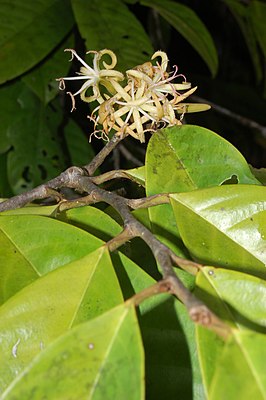Metteniusa
| Metteniusa | ||||||||||||
|---|---|---|---|---|---|---|---|---|---|---|---|---|

Metteniusa tessmanniana , flowers and leaves |
||||||||||||
| Systematics | ||||||||||||
|
||||||||||||
| Scientific name of the family | ||||||||||||
| Metteniusaceae | ||||||||||||
| H.Karst. | ||||||||||||
| Scientific name of the genus | ||||||||||||
| Metteniusa | ||||||||||||
| H.Karst. |
The metteniusa are the only genus in the family of Metteniusaceae and includes seven species that are native to South America.
description
Metteniusa are evergreen trees that reach a height of 4 to 20 meters, their branches are cork-pored , young twigs are tomentose . The alternate, stalked leaves are entire. The petiole is grooved towards the axis. The stomata sit in a cyclocytic arrangement on the surface facing away from the axis .
The axillary inflorescences are zymös and have two to four bracts and two to seventeen actinomorphic , hermaphrodite flowers . The five imbricated lying sepals have grown to about one third at the base and downy hairs on the outside of which bent back and on the inside red filzig hairy petals are fused , the crown is approximately 2 centimeters long.
The five around 0.8 centimeters anthers are moliniform, so the three branches have similar wings of a windmill from increased connective away in the center, where they on the stamens are anchored. The pollen are tricolporate. The upper permanent ovary is unicompartmental, unusual is the position of the ovule on the upper end of the carpel ( placentation ). The large, thread-like stylus is bare, the stigma is punctiform.
The fruit is a five-ribbed stone fruit with a woody endocarp . The seeds have abundant white endosperm .
distribution
The species of the genus are found in Costa Rica, Peru, Ecuador, Colombia and Venezuela in the eastern Andes at altitudes between 160 and 2000 meters.
Systematics
The Metteniusaceae are not assigned to any order within the Euasterids I. Their exact systematic position is still unclear.
The family includes only one genus with seven species:
- Metteniusa cogolloi Lozano : It occurs in Colombia.
- Metteniusa cundinamarcensis Lozano
- Metteniusa edulis H.Karst.
- Metteniusa huilensis Lozano
- Metteniusa nucifera (Pittier) Sleumer
- Metteniusa santanderensis Lozano
- Metteniusa tessmanniana (Sleumer) Sleumer : It was first described from Peru.
Botanical history
The genus and family were first described in 1859 by Gustav Karl Wilhelm Hermann Karsten , the type species is Metteniusa edulis H.Karst. The generic name honors the Leipzig botanist Georg Mettenius (1823–1866). The exact systematic position of the genus was unclear up to the present day, so the genus was placed among the Cardiopteridaceae and the Icacinaceae , but the view as a separate family prevailed with Gustavo Lozano's monograph in 1988, which made a significant contribution to the knowledge of the Metteniusa .
Molecular genetic studies have confirmed this classification and placed the family as an isolated basal taxon of a clade made up of mint-like , nightshade-like , gentian-like as well as predatory and vahlia plants . Most closely related, however, are the Oncothecaceae .
literature
- Polidoro Pinto, Gustavo Lozano (Ed.): Flora de Colombia. Volume 11: Gustavo Lozano-C., Nubia B. de Lozano: Metteniusaceae. Universidad Nacional de Colombia et al., Bogota 1988.
Individual evidence
Most of the information in this article has been taken from the sources given under references; the following sources are also cited:
- ↑ a b Gustavo Lozano-C., Nubia B. de Lozano: Una Nueva Especie de Metteniusa Karsten (Metteniusaceae) de Colombia. In: Novon. Vol. 4, No. 3, 1994, ISSN 1055-3177 , pp. 266-270.
- ↑ Angiosperm Phylogeny Group : An update of the Angiosperm Phylogeny Group classification for the orders and families of flowering plants: APG III. In: Botanical Journal of the Linnean Society. Vol. 161, No. 2, 2009, ISSN 0024-4074 , pp. 105-121, doi : 10.1111 / j.1095-8339.2009.00996.x .
- ↑ Lotte Burkhardt: Directory of eponymous plant names . Extended Edition. Botanic Garden and Botanical Museum Berlin, Free University Berlin Berlin 2018. [1]
- ^ Favio González, Julio Betancur, Olivier Maurin, John V. Freudenstein, Mark W. Chase: Metteniusaceae, an early-diverging family in the lamiid clade. In: Taxon. Vol. 56, No. 3, 2007, ISSN 0040-0262 , pp. 795-800.